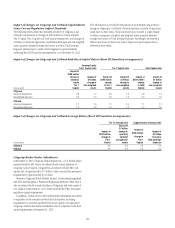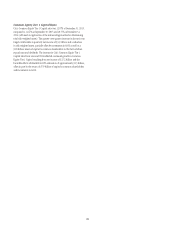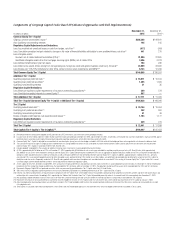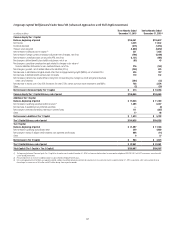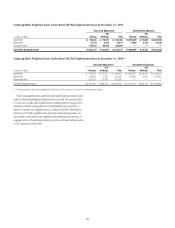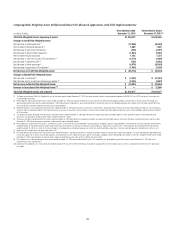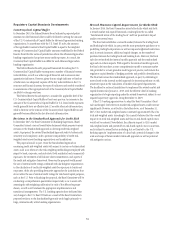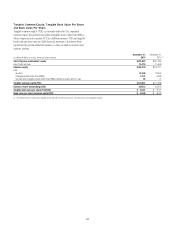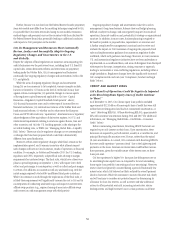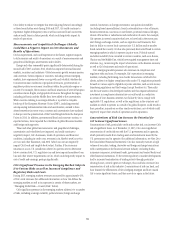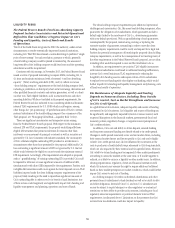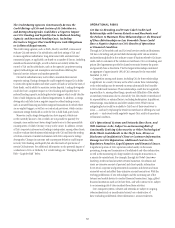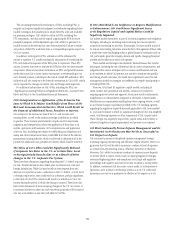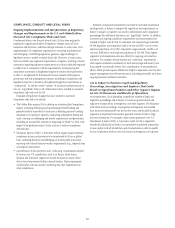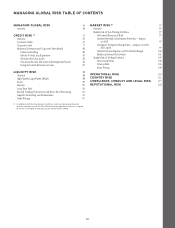Citibank 2015 Annual Report Download - page 71
Download and view the complete annual report
Please find page 71 of the 2015 Citibank annual report below. You can navigate through the pages in the report by either clicking on the pages listed below, or by using the keyword search tool below to find specific information within the annual report.53
RISK FACTORS
The following discussion sets forth what management currently believes
could be the most significant risks and uncertainties that could impact
Citi’s businesses, results of operations and financial condition. Other
risks and uncertainties, including those not currently known to Citi or
its management, could also negatively impact Citi’s businesses, results
of operations and financial condition. Thus, the following should not be
considered a complete discussion of all of the risks and uncertainties Citi
may face.
REGULATORY RISKS
Citi’s Inability to Enhance Its 2015 Resolution Plan
Submission Could Subject It to More Stringent Capital,
Leverage or Liquidity Requirements, or Restrictions on Its
Growth, Activities or Operations, and Could Eventually
Require Citi to Divest Assets or Operations.
Title I of the Dodd-Frank Act requires Citi to annually prepare and submit
a plan to the Federal Reserve Board and the FDIC for the orderly resolution
of Citigroup (the bank holding company), and its significant legal entities,
under the U.S. Bankruptcy Code or other applicable insolvency law in the
event of future material financial distress or failure (Title I Resolution
Plan). The Title I Resolution Plan requires significant effort, time and cost
across all of Citi’s businesses and geographies, and is subject to review by the
Federal Reserve Board and the FDIC.
Under Title I, if the Federal Reserve Board and the FDIC jointly determine
that Citi’s 2015 Title I Resolution Plan is not “credible” (which, although not
defined, is generally believed to mean the regulators do not believe the plan
is feasible or would otherwise allow the regulators to resolve Citi in a way that
protects systemically important functions without severe systemic disruption),
or would not facilitate an orderly resolution of Citi under the U.S. Bankruptcy
Code, and Citi fails to resubmit a resolution plan that remedies any identified
deficiencies, Citi could be subjected to more stringent capital, leverage or
liquidity requirements, or restrictions on its growth, activities or operations. If
within two years from the imposition of any requirements or restrictions Citi
has still not remediated any identified deficiencies, then Citi could eventually
be required to divest certain assets or operations. Any such restrictions or
actions would negatively impact Citi’s reputation, market and investor
perception, operations and strategy.
In August 2014, the Federal Reserve Board and the FDIC announced the
completion of reviews of the 2013 Title I Resolution Plans submitted by Citi
and 10 other financial institutions. The agencies identified shortcomings
with the firms’ 2013 Title I Resolution Plans, including Citi’s. These
shortcomings generally included (i) assumptions that the agencies regarded
as unrealistic or inadequately supported, such as assumptions about the
likely behavior of customers, counterparties, investors, central clearing
facilities and regulators; and (ii) the failure to make, or identify, the kinds of
changes in firm structure and practices that would be necessary to enhance
the prospects for orderly resolution. Significantly, the FDIC determined that
the 2013 Title I Resolution Plans submitted by the 11 institutions, including
Citi, were “not credible” and did not facilitate an orderly resolution under the
U.S. Bankruptcy Code. The Federal Reserve Board determined that the plans
of the 11 institutions were required to take immediate action to improve
their resolvability and reflect those improvements in their 2015 plans. At
the same time, the Federal Reserve Board and FDIC indicated that if the
identified shortcomings were not addressed in the 2015 Title I Resolution
Plan submissions, the agencies expected to use their authority under Title I,
as discussed above. Like other similarly-situated institutions, Citi submitted
its 2015 Title I Resolution Plan on July 1, 2015 and the industry has not yet
received a formal response from the regulators.
Citi’s Ability to Return Capital to Shareholders
Substantially Depends on the CCAR Process and the
Results of Regulatory Stress Tests.
In addition to Board of Directors’ approval, any decision by Citi to return
capital to shareholders, whether through an increase in its common stock
dividend or through a share repurchase program, substantially depends
on regulatory approval, including through the CCAR process required by
the Federal Reserve Board and the supervisory stress tests required under
the Dodd-Frank Act. In March 2014, the Federal Reserve Board announced
that it objected to the capital plan submitted by Citi as part of the 2014
CCAR process, meaning Citi was not able to increase its return of capital to
shareholders as it had requested. Restrictions on Citi’s ability to return capital
to shareholders as a result of the 2014 CCAR process negatively impacted
market and investor perceptions of Citi, and continued restrictions could do
so in the future.
Citi’s ability to accurately predict or explain to stakeholders the outcome
of the CCAR process, and thus address any such market or investor
perceptions, is difficult as the Federal Reserve Board’s assessment of Citi is
conducted not only by using the Board’s proprietary stress test models, but
also a number of qualitative factors, including a detailed assessment of
Citi’s “capital adequacy process,” as defined by the Federal Reserve Board.
These qualitative factors were cited by the Federal Reserve Board in its
objection to Citi’s 2014 capital plan, and the Board has stated that it expects
leading capital adequacy practices will continue to evolve and will likely
be determined by the Board each year as a result of its cross-firm review of
capital plan submissions.
Similarly, the Federal Reserve Board has indicated that, as part of its stated
goal to continually evolve its annual stress testing requirements, several
parameters of the annual stress testing process may be altered from time to
time, including the severity of the stress test scenario, Federal Reserve Board
modeling of Citi’s balance sheet and the addition of components deemed
important by the Federal Reserve Board (e.g., a counterparty failure). In
addition, the Federal Reserve Board indicated that it may consider that some
or all of Citi’s GSIB surcharge be integrated into its post-stress test minimum
capital requirements. These parameter and other alterations could further
increase the level of capital Citi must meet as part of the stress tests, thus
potentially impacting the level of capital returns to shareholders.


